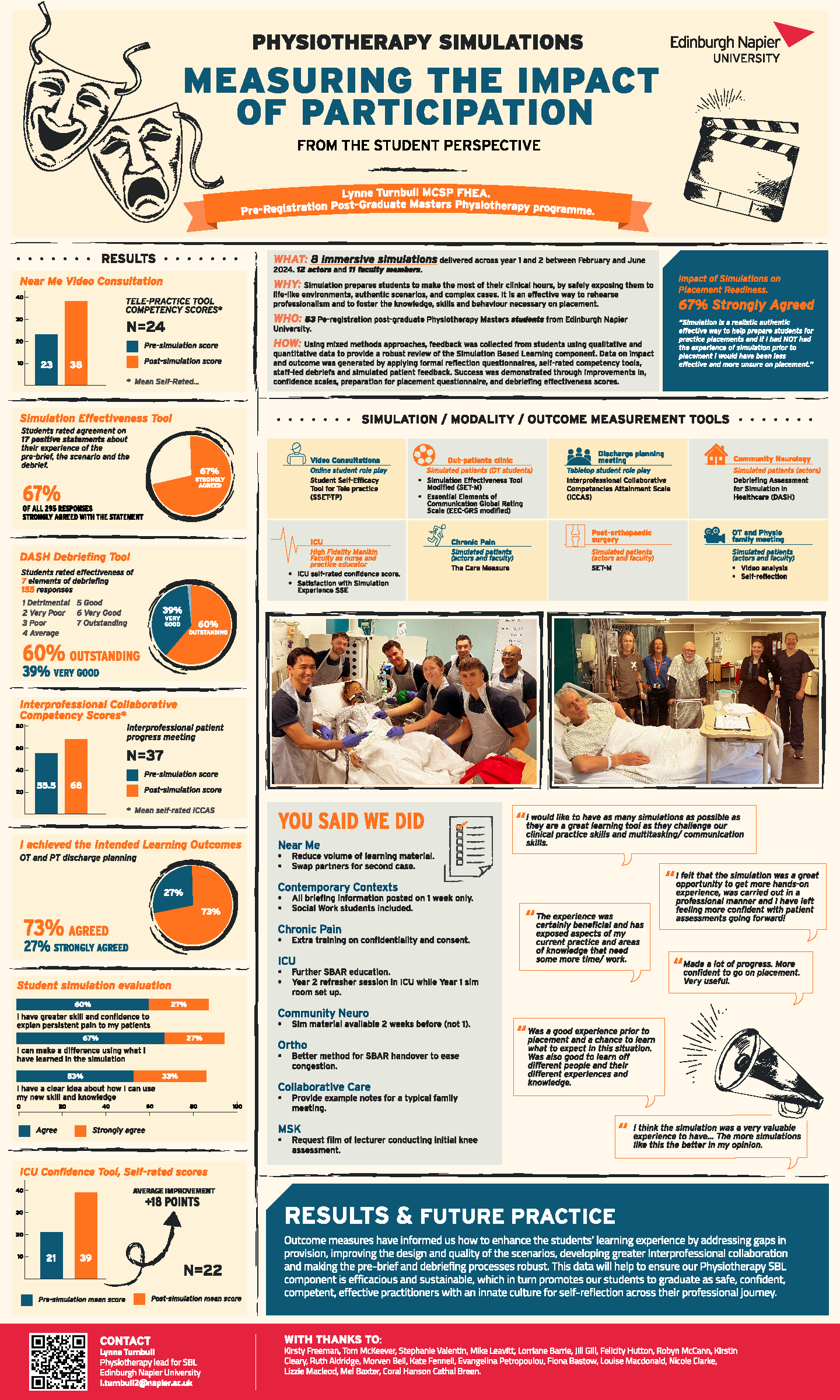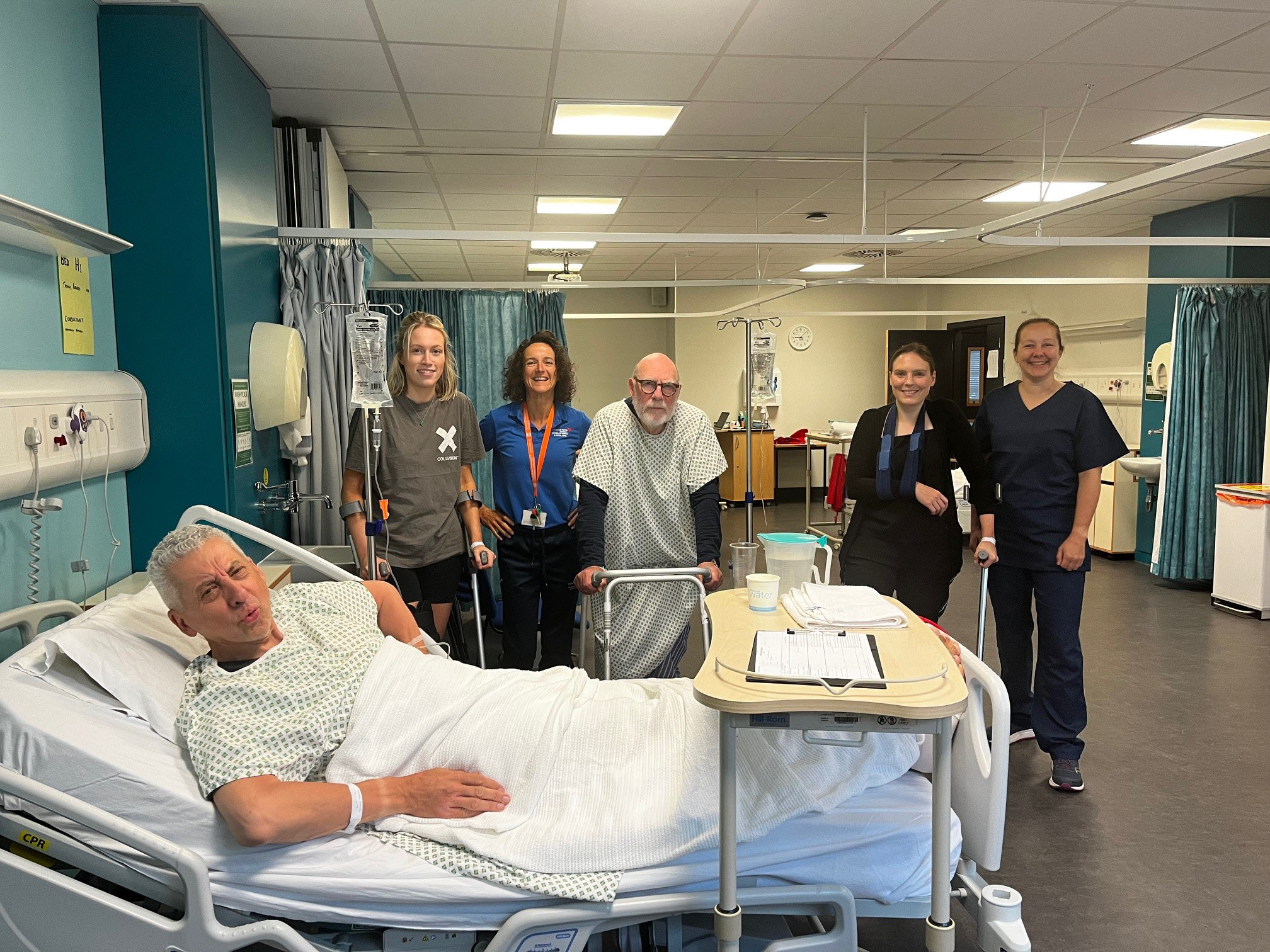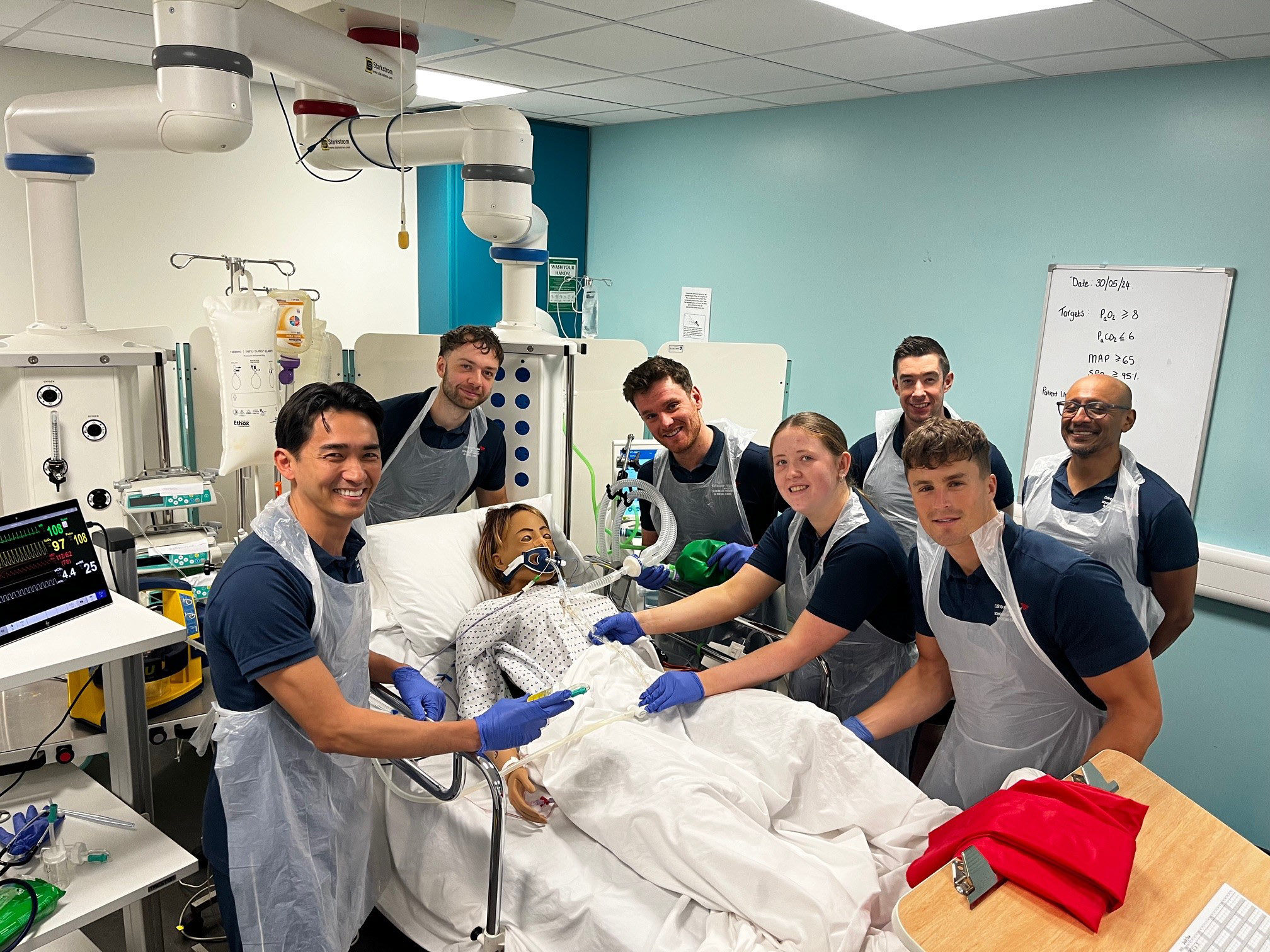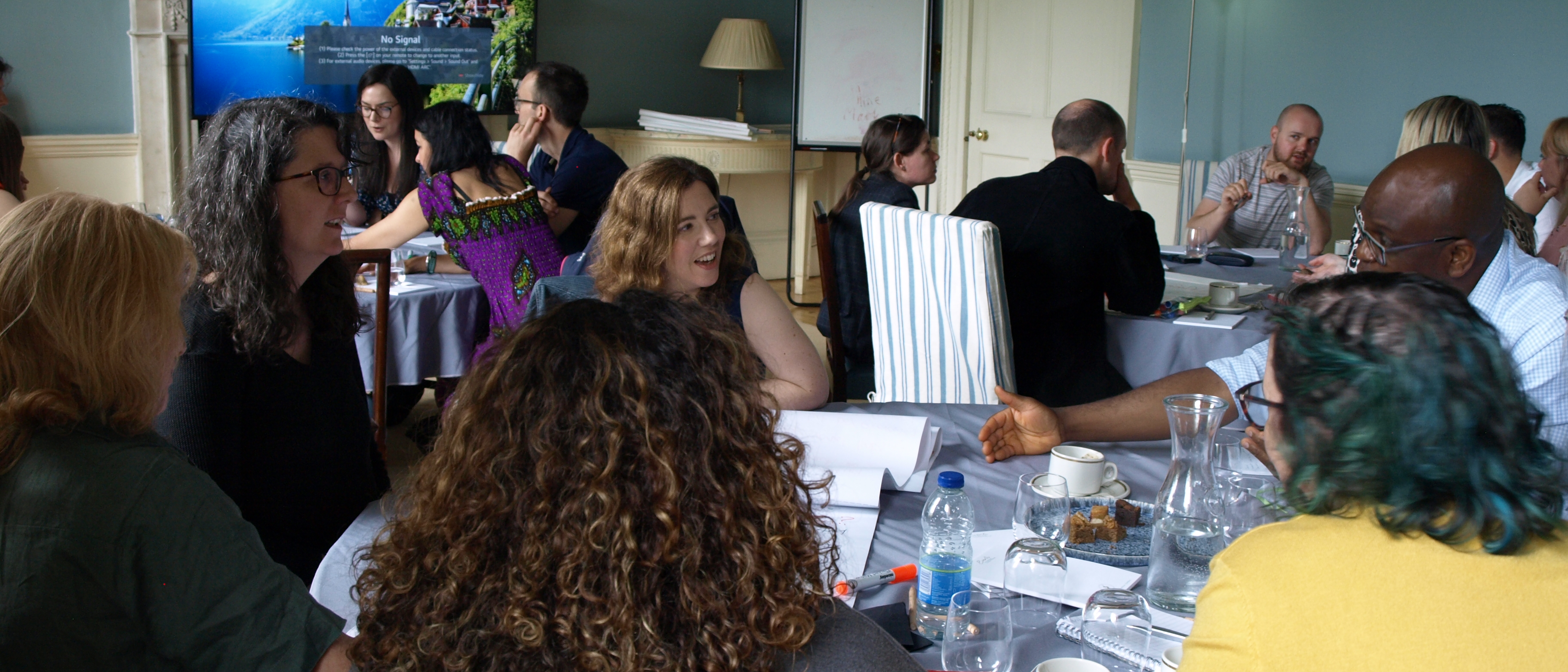
Lynne Turnbull in the School of Health & Social Care and has spent three years developing simulation-based education (SBE) as part of the learning & teaching methods for the MSc Physiotherapy programme. Previously only one simulation ran for this programme, using lecturers as simulated patients, and without a full debrief. The introduction of Simulated Patients (SPs) increased fidelity and contributed to a deeper learning experience for students. Time is now protected for a full debrief after each simulation, key to the learning cycle, using a validated framework.
The poster at the bottom of this post highlights some student perceptions of the benefits of the (interprofessional) simulations.
Simulated Patients
Enhancing the SBE in Physiotherapy, enabled learners to practice the softer skills of communication such as patient education or presenting at a Multidisciplinary meeting. The SP’s played the part of a patient, a carer, a spouse or a parent to challenge the students to manage complex scenarios. Rehearsing technical skills such as suctioning or auscultation was facilitated using the University’s high-fidelity manikins with nurse tutors playing the part of the ICU (Intensive Care Unit) nurse. Practical skills of joint ligament testing or measuring range of motion were gained using SPs who could react spontaneously and whose limbs enabled real feel. Lynne approached the ENU Director of Marketing & External Relations, who participated as an SP, allowing him the opportunity to widen his understanding of ENU simulation practices, to appreciate its impact and to increase Physiotherapy’s profile. He said he loved the opportunity to see at grassroots how the team are innovating collaborating and practising teaching which embraces Equality, Diversity and Inclusion.

Interprofessional Learning (IPL)
IPL is a key aspect in modern healthcare practice and was embodied through simulations involving students from other disciplines within the School of Health & Social Care, helping students to learn the importance of their interconnected roles. A discharge planning meeting with Occupational Therapy and Physiotherapy explored student biases and identified service user challenges. The simulation helped students to identify how individual professions contribute to the team.
Physiotherapy and Occupational Therapy students work together on a range of scenarios, including a home environment where students set goals in collaboration, following a home visit. Another scenario with a patient and carer helped interprofessional students develop their communication skills when the situation becomes emotive. Having filmed this interaction, the students were asked to reflect on their performance in the simulation for an assignment. Self-reflection and peer review are factored into the SBE. Athletes, played by Occupational Therapy students, provided the Physiotherapy students with an opportunity to practice their SBAR handover (Situation, Background, Assessment Recommendations) and patient handling skills when a patient is in pain. The student SPs were able to see how it feels to be a patient and the impact that therapist communication and positioning has on the patient. This year (2024/25) the Social Work programme students will join the simulation to enrich the learning experience and allow these students to also engage in applied, authentic learning replicating practice situations.
Inter-professional simulations are more challenging due to contrasting timetabling needs, so Lynne advises to look for simulations already running and to collaborate on joint scheduling and learning outcomes, a year in advance. Joining an existing nursing simulation and creating new opportunities for Physiotherapy, Lynne plans to participate as a future SP. Volunteering to act in the patient role provides crucial insight and will assist when creating collaborative cases with the nursing team.

Inter-School collaboration
Working across schools is a desirable ethos with mutual benefits, promoting inter-disciplinary partnership with students from diverse backgrounds. For example, to support filming and editing, Lynne hosted 10 SACI (School of Arts & Creative Industries) students on short placements to record one of the simulations and to create six pre-simulation resource films.
CPD
To support her own evidence-based practice, Lynne used the broader simulation community. She sought advice from school colleagues already using simulations, e.g, limiting the number of Intended Learning Outcomes and reducing cognitive load for students. A scenario can have high fidelity but low authenticity, so it is important to look at the case study and intended learning, not just the facilities. Lynne has learned to expand the use of active observers as co-debriefers which promotes inclusion.
She linked with Lothian Medical education, ASPiH journal club, and The Society for Simulation in Europe (SESAM). Working with large numbers of students can be challenging, with limited hours to get them all through a 30-minute scenario, striving for small group sizes to enable each learner to have the maximum amount of time participating. A new “tag-in” method was adopted, which improved flow. This was suggested by Lynne’s Australian Simulation Mentor which she sourced through SESAM. She also secured a “simulation buddy” at the University of Northampton, and they regularly converse, and problem solve online. Lynne values the ENU Special Interest Group for Simulation Based Education (SIGSBE) managed by Cathal Breen and Catherine Mahoney, as a forum for sharing good practices, and exploring research, templates and current ideas.
Summary
The Physiotherapy programme engaged a total of 22 SPs comprising 7 actors 5 external students and 10 faculty members. Lynne has access to the local amateur dramatics network and the clinical skills centre holds a register of volunteers. Using ENU students as SP’s promotes diversity of patient population and generates reciprocal benefit. Having colleagues from other programmes and various parts of the university taking part in simulations allows them to experience for themselves the purpose of simulation as a form of learning and teaching and how it functions in practice. This helps in building relationships, sharing ideas amongst diverse colleagues and developing understanding of simulated practice pedagogy at ENU. It also exposes colleagues to the challenges facing the programme as well as their creativity in addressing these. Immersive simulation is resource intensive but can be transformative in preparing students for practice and success beyond their studies.
67% of students strongly Agreed that simulation is a realistic authentic effective way to help them prepare for practice placement and felt that if they had not had the experience of simulation prior to placement they would have been less effective and more unsure on placement, highlighting the value of simulation as an important and effective area of focus for IPL and learning and teaching at ENU going forward.
The Chartered Society of Physiotherapy (CSP) is considering whether up to 20% of Practice Based Learning may include simulation, in order to future proof clinical placement hours in the event of another pandemic.
Student feedback
“I would like to have as many simulations as possible as they are a great learning tool as they challenge our clinical practice skills and multitasking /communication skills.”
“The experience was certainly beneficial and has exposed aspects of my current practice and areas of knowledge that need some more time and work”
“… was a good experience prior to placement and a chance to learn what to expect in this situation, was also good to learn off different people and their different experiences and knowledge.”
Lynne wishes to highlight that she would not have been able to deliver high quality simulation without incredible support from the Allied Health Professions team of lecturers, and the fabulous staff in the simulation and clinical skills centre.

Leave a Reply